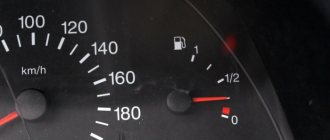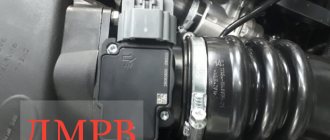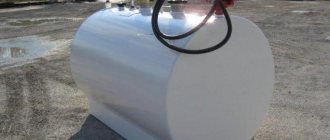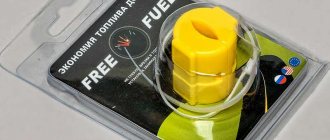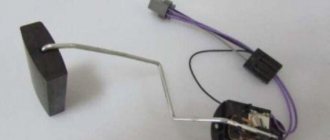Business lawyer > Accounting > Accounting and reporting > How the formula for calculating fuel consumption for vehicles is used
Formula for calculating fuel consumption
Our article talks about how the formula for calculating fuel consumption is used, what standards govern such calculations, and what benefits this information can bring.
It should be noted that for a company that does not own vehicles, this information will not be as useful. And for car (vehicle fleet) owners - this will help:
- Reduce fuel consumption;
- Increase the service life of the main units;
- Keep reports;
- Determine the cost of transportation;
- Make correct payments to employees using personal vehicles for business purposes.
How to reduce fuel consumption and increase engine life
The consumption of fuels and lubricants is influenced by a whole set of factors:
- Driving manner and style, which depend on the climatic conditions in the region where the car is operated, the character traits of the car owner, this also includes the experience (duration) of driving and the brand of the vehicle itself.
- The type of fuel and lubricant used, since when switching to a higher octane number there is a loss of power - the remaining gasoline will heat the engine and consumption will increase. It is possible to change the type of fuel if the car is equipped with technology that helps adjust the ignition angle.
- Engine operation, or rather its general condition: spark plugs, since insufficient spark directly affects the operation of the ignition system, and gasoline consumption increases; oxygen sensor, because its failure worsens the power characteristics and, as a result, fuel consumption also increases.
Remember:
Warming up the car engine certainly contributes to the additional fuel consumption, but this forced procedure cannot be avoided. By warming up the engine, you give the lubricant the opportunity to fill all the outlet pipes and channels of the system. For example, film-coated engine cylinders will last twice as long. Warming the seats and the entire interior is at the discretion of the owners.
Credits cash
Online calculation program on the Credits cash portal (https://creditscash.com.ua/services/fuel-4).
In the services section there is a fuel calculator. all calculations can be done online
It can be calculated:
- the cost of travel;
- average fuel consumption;
- distance for a certain amount of fuel.
Data required to calculate the cost of the trip:
- estimated travel distance;
- fuel consumption per 100 kilometers (average figures);
- price for 1 liter of fuel.
Average fuel consumption:
- fuel capacity;
- trip mileage.
Fuel quantity:
- average fuel consumption data;
- amount of fuel in the fuel tank.
A simple program that does not require installation, works online.
Calculation of fuel consumption per 100 km using an algorithm
How fuel and lubricants are calculated is useful for every vehicle driver to know, since this process takes little time and helps to find out exactly how much money needs to be allocated for refueling the car during long trips.
In order to make an accurate calculation it is necessary:
- Fill the fuel tank full - take the odometer readings.
- After the run, fill the fuel tank full again and take the meter readings.
Calculation of fuel and lubricant costs per 100 km is based on the fuel filled at the second filling station, according to the indications of the sales receipt
The most common formula for calculating fuel consumption, it is also considered one of the most practical and effective:
X = L/(S/100) or X = (L/S)x100
In which:
- “L” is fuel by number of liters,
- “S” – distance divided by the amount of fuel and lubricants,
Calculation:
The fuel tank holds 30 liters and the distance traveled is 376 km.
30: 3.76 = 7.99 liters will be fuel costs per 100 km.
It would be more correct to calculate fuel consumption when the vehicle travels more than 1000 km. This way it will be more accurate and you will be able to see the full picture.
How do gasoline or diesel fuel consumption calculators work?
If you don't have a calculator handy and you're not good at simple math or don't feel like doing everything in your head, you can also use a fuel calculator. On the Internet you will find many different calculators for calculating gasoline or diesel fuel consumption. To do this, enter the query “fuel consumption calculator” in the search bar of any search engine. In response to your request, you will receive a huge number of links to various online calculators that help calculate fuel consumption.
See also: Fuel economy: How much fuel is used to operate the air conditioning and other systems
Most online online calculators will help you calculate not only the average fuel consumption, but also the cost of a trip over any distance. You can also calculate the cost of 1 kilometer of travel.
Basic standards for calculating fuel consumption
Standards for calculating fuel consumption
The cost rate for fuels and lubricants is the average amount of fuel and lubricants consumed for certain types of vehicles, taking into account the distance traveled.
According to the recommendations of the Ministry of Transport of the Russian Federation for 2021, enterprises have the right to calculate the consumption of fuels and lubricants that have vehicles on their balance sheet independently, or taking into account the requirements. The main document that guides enterprises is Order of the Ministry of Transport of the Russian Federation N AM - 23 - p dated March 14, 2008.
In 2015, the increasing coefficients for operated transport in the city, where the population is more than 5 million people, underwent minor changes. In addition, by Order of the Ministry of Transport of the Russian Federation N - 80 - p dated July 14, 2015, the list of vehicle models for organizations and enterprises has been expanded.
Basic rates are adjusted taking into account the following coefficients:
- In winter: Far North, North, Siberia from +15% to +20%; Center, Urals from +10% to +12%; Southern regions from +5% to +7%.
- Based on the number of people living in the urban district where the vehicle is operated: up to two hundred and fifty thousand +10%; up to one million +15%; up to three million +20%; more than three million + 25%.
- In addition, the mileage and year of manufacture of the vehicle are taken into account; connecting the interior cooling system (air conditioning); movement of large cargo, as well as the type of fuel and lubricants being refueled.
Why fuel consumption may be too high
Please note: our hypothetical figure of 9.3 l/100 km is not the worst result of average fuel consumption. Let’s say this is exactly how much you should have gotten, but calculations showed, say, 12-14 liters at the usual rhythm of movement. What are the reasons for the excessive consumption of “golden” fuel today? There are a lot of them, starting with driving style and ending with numerous technical faults.
Before looking for the cause in technical problems, we suggest starting small, and first check the tire pressure. If they are reduced, then the engine's appetite may increase quite noticeably. Is there a roof rack? It creates aerodynamic drag and this also increases the fuel consumption of your car. And the turned on air conditioner can also have its say.
Control of fuel and lubricant costs by satellite tracking system
Control of fuel and lubricant costs by satellite tracking system
The company's accountant enters the amount of fuel consumed in accordance with the above standards. In addition to the column “material costs” for adding consumed fuel and lubricants in excess of the norm, there is a column “non-operating costs”.
There is a formula for calculating fuel consumption for a bus:
Qн = 0.01 x Hs x S x (1 + 0.01 x D) + Note x T, (2)
- Qн – costs in accordance with standards,
- Hs – standard fuel and lubricant costs, taking into account the distance traveled l/100 km,
- S – distance traveled,
- Note – standard fuel and lubricant costs, taking into account the use of standard heaters,
- T – operating time with interior heating turned on,
For dump trucks:
Qн = 0.01 x Hsanc x S x (1 + 0.01 x D) + Нz x Z, (4)
- Z – the sum of flights made in one shift.
For trucks:
Qн = 0.01 x (Hsan x S + Hw x W) (1 + 0.01 x D), (3)
- W – volume of work performed.
A satellite tracking system is a fairly effective way to control fuel and lubricant costs.
The use of such a system involves the use of data on the distance traveled by vehicles, which is processed using information received from a satellite, without taking into account the ondometer readings.
The main advantages of the satellite system include:
- Possibility of obtaining daily information about the exact distance traveled by the vehicle.
- Information about the total time spent on work.
- Data about the time of movement and each stop.
- Controlling the speed limit.
The system has a small error (only 1.5%), but is able to prevent unauthorized increases in fuel consumption. In addition, it is possible to automatically calculate the cost of fuel and lubricants according to the relevant standards, where the formula for calculating fuel consumption presented above is taken as a basis.
Two possible calculation methods:
- According to the time of movement of the vehicle.
- According to the distance traveled.
There are various ways to purchase fuel: cash, coupons, bank cards, etc.
For cash payments, it is necessary (by order of the organization) to approve the entire procedure for this procedure, namely: to appoint responsible accountable persons who are obliged to fill out documentation on the money spent within a certain period of time, attaching sales receipts and waybills.
Top
Write your question in the form below
Excel program
You can calculate fuel costs in an Excel spreadsheet. To get accurate data you need to:
- calculate the route and take into account all gas stations on it;
- take into account the distance between gas stations;
- take into account fuel consumption;
- stick to the chosen route.
If all conditions are met, the calculation error reaches +- 1%.
We recommend watching the video: calculating fuel consumption using a formula in an Excel table.
The table is made on a regular Excel sheet and filled with formulas. Designed for calculation when filling a full tank. Data to be entered:
- travel date – month and day;
- mileage, indicate in hundreds of km;
- price for 1 liter of gasoline;
- the amount for which fuel was purchased.
There are hidden columns for automatic calculation based on previously entered data. The program can be installed on your computer. The table is designed for a route up to 16 thousand kilometers long. Once filled out, you can print it.
Formula for calculating fuel consumption
The volume of fuel consumed by a car can be calculated using the formula: Qн = 0.01*Hs*S*(1 + 0.01 x D), where
- Qn - consumption rate (in l);
- Hs - basic diesel fuel consumption specified by the manufacturer (in liters per 100 km);
- S — speedometer mileage (in km);
- D is a coefficient that can decrease or increase the final figure.
The coefficient must be selected based on parameters such as:
- Availability of an air conditioning or climate control system - +7%;
- Operation of automatic telephone exchanges within a city where at least 250,000 people live - +15%;
- Vehicle mileage more than 100,000 km and service life 5 years or more - +5%;
- Norms by region. Depending on climatic conditions, it can increase up to 20%.
There is also a formula that allows you to calculate the fuel consumption of cars per unit of time:
Q = N*q/(1000*R*k1), where
- N - motor power in hp. (kW);
- q is the specific fuel consumption of a diesel engine;
- R is the density of diesel fuel (0.85 kg/dm3);
- k1 is a coefficient that indicates the ratio of the internal combustion engine operating time at maximum crankshaft speed (%);
- Q - fuel consumption (l/hour).
The driver can use the received data for purposes such as:
- Optimization of costs for the purchase of diesel fuel.
- Avoiding situations that could cause a lack of fuel on the road.
- ATS diagnostics. The fuel consumption regime should be checked once every 6 months and compared with the base value specified by the vehicle manufacturer. Significant deviations may indicate malfunctions in the main components and assemblies of the machine.

